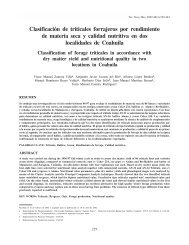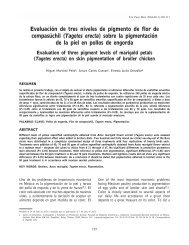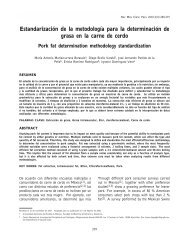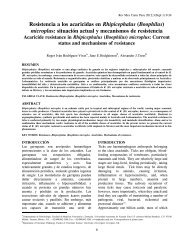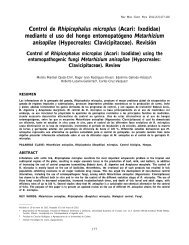Digestibilidad de nutrimentos en lechones alimentados con dietas ...
Digestibilidad de nutrimentos en lechones alimentados con dietas ...
Digestibilidad de nutrimentos en lechones alimentados con dietas ...
Create successful ePaper yourself
Turn your PDF publications into a flip-book with our unique Google optimized e-Paper software.
DIGESTIBILIDAD DE NUTRIMENTOS EN LECHONES ALIMENTADOS CON SOYA<br />
<strong>de</strong> soya (APS) (84.2 vs 83.6 %); para la proteína<br />
cruda (nitróg<strong>en</strong>o) la digestibilidad ileal apar<strong>en</strong>te<br />
(DIA) fue más baja <strong>en</strong> el pres<strong>en</strong>te trabajo (80.1 vs<br />
88.3 %). En el caso <strong>de</strong> la dieta <strong>con</strong> <strong>con</strong>c<strong>en</strong>trado<br />
<strong>de</strong> proteína <strong>de</strong> soya (CPS) los resultados obt<strong>en</strong>idos<br />
fueron inferiores tanto para la materia seca (79.3<br />
vs 82.7 %) como para la proteína cruda (76.4 vs<br />
82.7 %). En relación al trabajo <strong>de</strong> Cho et al (25) se<br />
observa que los pres<strong>en</strong>tes valores <strong>de</strong> DIA fueron<br />
mayores para la materia seca (84.2 vs 80.1 %) y<br />
m<strong>en</strong>ores para la proteína cruda (80.1 vs 85.1 %). Por<br />
otro lado, Chae et al (29) obtuvieron valores inferiores<br />
a los <strong>de</strong>l pres<strong>en</strong>te trabajo para la digestibilidad <strong>de</strong> la<br />
materia seca (78.7 vs 84.2 %) y ligeram<strong>en</strong>te<br />
superiores para la proteína cruda (83 vs 80.1 %)<br />
<strong>en</strong> <strong>dietas</strong> complem<strong>en</strong>tadas <strong>con</strong> APS. Los resultados<br />
<strong>de</strong> DIA pres<strong>en</strong>tados <strong>en</strong> este trabajo y <strong>en</strong> la literatura<br />
<strong>con</strong>sultada muestran el bu<strong>en</strong> valor nutricional <strong>de</strong> las<br />
fu<strong>en</strong>tes <strong>de</strong> proteína utilizadas; sin embargo, también<br />
se reportan (26) valores más bajos que los anteriorm<strong>en</strong>te<br />
m<strong>en</strong>cionados, cuando se utilizaron <strong>dietas</strong> a base <strong>de</strong><br />
maíz–CPS (72.3 y 65.4 % para DIA-MS y DIA-PC,<br />
respectivam<strong>en</strong>te) o maíz-APS (73 y 67.1 % para<br />
DIA-MS y DIA-PC, respectivam<strong>en</strong>te).<br />
La DTA y DIA <strong>de</strong> la <strong>en</strong>ergía <strong>de</strong> las tres <strong>dietas</strong><br />
experim<strong>en</strong>tales muy probablem<strong>en</strong>te está relacionada<br />
<strong>con</strong> la gran cantidad <strong>de</strong> almidón <strong>con</strong>t<strong>en</strong>ida <strong>en</strong> éstas,<br />
el cual ti<strong>en</strong>e una digestibilidad cercana al 100<br />
% (9,30) . En un trabajo (31) <strong>en</strong> don<strong>de</strong> se emplearon<br />
<strong>dietas</strong> a base <strong>de</strong> suero <strong>de</strong> leche y <strong>con</strong>c<strong>en</strong>trado <strong>de</strong><br />
proteína <strong>de</strong> soya sin la adición <strong>de</strong> almidón, se<br />
reportan valores inferiores <strong>de</strong> digestibilidad <strong>de</strong> la<br />
<strong>en</strong>ergía <strong>en</strong> relación a la dieta CPS a nivel ileal (68<br />
vs 81.6 %) y fecal (81 vs 87.8 %). La pres<strong>en</strong>cia<br />
<strong>de</strong> lactosa <strong>en</strong> la dieta APS pudo haber sido un<br />
factor que <strong>con</strong>tribuyó a la mayor DIA-En <strong>en</strong><br />
relación a las <strong>dietas</strong> APSSL, pues se reporta que<br />
<strong>en</strong> animales alim<strong>en</strong>tados <strong>con</strong> <strong>dietas</strong> complem<strong>en</strong>tadas<br />
<strong>con</strong> lactosa <strong>en</strong> su forma cristalina, <strong>en</strong> comparación<br />
<strong>con</strong> una dieta <strong>con</strong> suero <strong>de</strong> leche <strong>de</strong>shidratado,<br />
estimula la actividad <strong>de</strong> la lactasa, mejorando el<br />
proceso <strong>de</strong> digestión <strong>de</strong> la <strong>en</strong>ergía (4) .<br />
Una probable explicación a la mejor digestibilidad<br />
<strong>de</strong> la dieta <strong>con</strong> APS como fu<strong>en</strong>te única <strong>de</strong> proteína<br />
durante los dos primeros periodos <strong>de</strong>l estudio, se<br />
basa <strong>en</strong> la observación <strong>de</strong> algunos autores (32,33) ,<br />
307<br />
synthesis or their carbon chains as an <strong>en</strong>ergy source<br />
and the amino group is <strong>con</strong>verted into ammonia<br />
which is absorbed at the large intestine and excreted<br />
as urine (26) . This ferm<strong>en</strong>tation process reduces the<br />
amount of nutri<strong>en</strong>ts excreted in feces, thus<br />
overestimating their digestibility (27) .<br />
Effect of protein source<br />
Appar<strong>en</strong>t total digestibility (ATD) coeffici<strong>en</strong>ts of<br />
nutri<strong>en</strong>ts show that the protein sources being studied<br />
are highly digestible, from the first week post weaning<br />
onwards. ATD values for dry matter and cru<strong>de</strong> protein<br />
of diets ad<strong>de</strong>d with soy protein isolated were similar<br />
to those reported in literature (14,15) . Piglets fed with<br />
diets <strong>con</strong>taining soy protein <strong>con</strong>c<strong>en</strong>trate showed dry<br />
matter total digestibility similar to those reported by<br />
Fries<strong>en</strong> et al (6) . However, these results were lower<br />
than those reported by other authors (14,15) . ATD of<br />
nutri<strong>en</strong>ts in diets <strong>con</strong>taining dried whey (SPIDW)<br />
observed in the pres<strong>en</strong>t study <strong>con</strong>firms some previous<br />
reports (28) showing high dry matter (87 %) and<br />
nitrog<strong>en</strong> (88 %) digestibility in diets ad<strong>de</strong>d with dried<br />
whey. Studies on ileal digestibility of diverse protein<br />
sources in rec<strong>en</strong>tly weaned piglets are few, however,<br />
wh<strong>en</strong> results obtained in the pres<strong>en</strong>t study are<br />
compared to those reported by Shon et al (15) , these<br />
last authors obtained slightly lower values for dry<br />
matter digestibility in diets based on soy protein isolated<br />
(SPI) (84.2 vs 83.6 %), while cru<strong>de</strong> protein (nitrog<strong>en</strong>)<br />
appar<strong>en</strong>t ileal digestibility (AID) values were lower in<br />
the pres<strong>en</strong>t study (80.1 vs 88.3 %). In diets <strong>con</strong>taining<br />
soy protein <strong>con</strong>c<strong>en</strong>trate (SPC), results obtained were<br />
lower both for dry matter (79.3 vs 82.7 %) and cru<strong>de</strong><br />
protein (76.4 vs 82.7 %). Results obtained in the<br />
study carried out by Cho et al (25) for AID are lower<br />
than those obtained in this study for dry matter (80.1<br />
vs 84.2 %) and higher for cru<strong>de</strong> protein (85.1 vs<br />
80.1 %). On the other hand, Chae et al (29) obtained<br />
lower values than those obtained in the pres<strong>en</strong>t study<br />
for dry matter digestibility (78.7 vs 84.2 %) and<br />
slightly higher values for cru<strong>de</strong> protein (83.0 vs<br />
80.1 %) in diets ad<strong>de</strong>d with SPI. Results for AID<br />
shown in the pres<strong>en</strong>t study and in the cited literature<br />
show the good nutritional value of the protein sources<br />
used, however lower values were reported (26) wh<strong>en</strong><br />
using diets based on maize-SPC (72.3 and 65.4 %<br />
for DM AID and CP AID, respectively) and maize-



